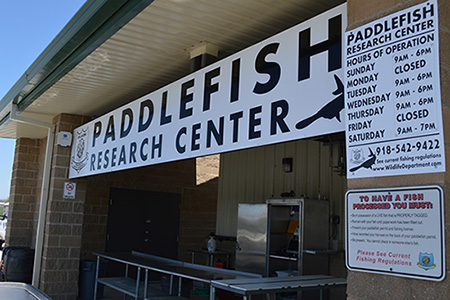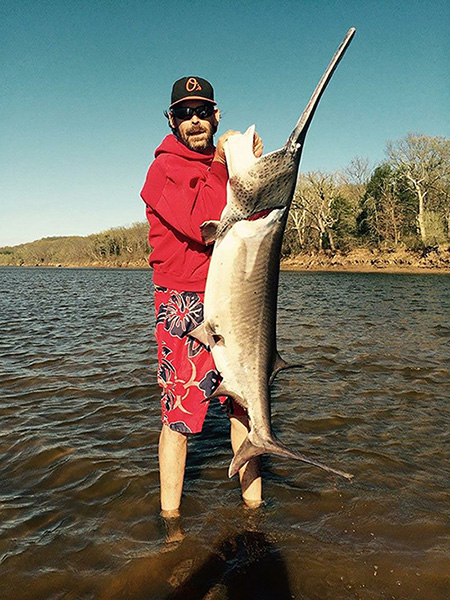Research on Oklahoma paddlefish going swimmingly
Wednesday, February 8, 2017

It looks like a dinosaur. It has the body composition of a shark. Its Pinocchio-nose is about a third the length of its body. It’s a filter-feeding, migratory monster of freshwater. And, if you hook one, hold on because it will give you the fight of your life.
Snagging a paddlefish, or spoonbill, depending on where you are from, in select Oklahoma river systems has exploded in popularity among anglers. The thrill of dragging a treble hook through the moving water and foul hooking these unique fish brings hundreds people to riverbanks around the state every spring.
“It’s really a unique fish,” said Jim Long, assistant unit leader for the Oklahoma Cooperative Fish and Wildlife Research Unit and adjunct associate professor at Oklahoma State University. “They are very much like a shark in many ways., but they only eat plankton so they have to be caught by snagging.”
The fish has only one bone, its jawbone, which plays a vital role in the management of the species (continue reading). The long paddle protruding from its face is full of electrosensors, allowing the fish to find large groups of plankton to eat.

The most eager of the spoonbill are young males, who sometimes travel upstream a little prematurely, where they anxiously await the arrival of the following females. A water temperature of about 55F and a big rain can trigger a spawn, according to Brandon Brown, Oklahoma Department of Wildlife Conservation Paddlefish Program coordinator.
During the heart of the season, usually late March through April, anglers can take advantage of the Paddlefish Research Center in Miami, Oklahoma, operated by the ODWC. Live fish can be taken to the center from March 1 through April 30 to be processed and fileted, free of charge.
“The program the ODWC is running is great for the people and the fish up there,” Long said. “Licensed fishermen are helping the fish management goals of the wildlife department and getting their fished cleaned properly, ready to take home and enjoy.”
Since the program began in 2008, nearly 40,000 fish have been checked into the PRC. Biologists at the center remove the jawbones (see, I told you) to age the fish and get biological data and then take length and weight measurement.
“Prior to 2008, we had no data on paddlefish,” Brown said. “When we started this program, right away, we’re getting data on 4,500 fish. That’s a lot of data to go from no fish to 4,500 fish in a year.”
Immediately, ODWC biologist knew there was huge population of paddlefish in the state, and based on the data they pulled from the first year’s harvest, had to prepare for the future.
“The majority of them were spawned in 1999. The fishing was great. These were big fish, there was a ton of them, this is the best paddlefishing of our lifetimes,” Brown said. “But, because of this program and the data we had, we were able to look down the road and see this big storm we had brewing on the horizon and know these fish were going to start dying from natural mortality about 5 years down the road.”
In 2009, there was a big spike in numbers of paddlefish checked in to the PRC, as more than 7,000 fish were processed.
“That’s when we said we had to do something and get out in front of this,” Brown said. “We told the anglers what was going on and they supported us and we implemented a whole string of new regulations designed to reduce that harvest in the short-term to ensure the resource would be there for harvest in the long-term.”
For the next four years, 2010-2013, the PRC saw a steady decrease in harvested fish. On average there were about 4,500 fish going through the system. Then, as that 1999 year class began to naturally decline, a new bag limit was implemented by the ODWC. Anglers went from being able to keep one fish per day all year long to a total of two fish per year.
“Since we’ve implemented that new limit, the harvest has been within a couple hundred fish since 2014. That was absolutely intentional. Paddlefish don’t spawn every year like bass or crappie. They spawn every few years,” said Brown. “We wanted to protect that year class for several years while another year class came up to take its place. And, it worked.”
Since the new bag limit was put in place in 2014, the PRC has processed about 2,500 spoonbill annually.
“We are happy with where the harvest is now. We know we have some strong year classes coming in the future. We had a really good spawn in 2015,” said Brown. “When we make a regulation, we want to be the least intrusive we can be and still have the effect. We don’t want to regulate just for the sake of regulation.”
While the ODWC is conducting research and managing for the population of this species, there is more to the story for anglers and the PRC. The center will clean and filet the fish for anglers and harvest the female eggs to be sold at auction as caviar. The caviar production and sales help fund all of the projects through the ODWC, not just paddlefish research.
“Caviar production is not the focus of what we’re doing,” Brown said. “We’re biologists. We’re managing a population and this program is working.”
It is working for the paddlefish. It is working for the anglers. It is working for the ODWC. And, it’s working for people who like caviar.
